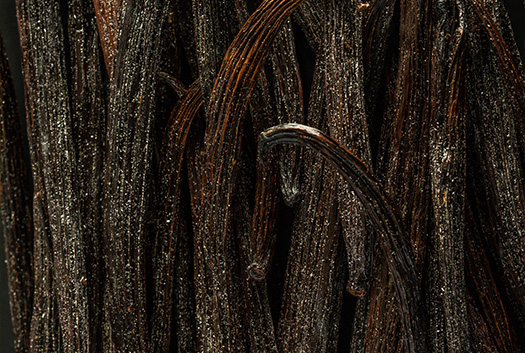A Brief Intro into Vanilla Flavor
In this article, we’re delving into the intricacies of the natural vanilla flavor profile.
Vanilla flavor is broad and is estimated to be comprised of 300 natural flavor constituents. One of these constituents is vanillin. Vanillin is a specialized naturally occurring constituent found predominantly in vanilla species. The biosynthetic pathway leading to its formation is not fully elucidated, yet we do know that vanillin accumulates during chemical maturation on the vine as a glycoside form (glucovanillin) that is subsequently broken down to vanillin post-harvest during curing.
Vanillin is responsible for approx. 70% of the aroma derived from natural vanilla. Now, while this may seem like a random scientific fact, it is actually very unique. Usually, a single major constituent found in most edible plants is responsible for 5%-10% of their volatile fraction. But vanilla is different, as its major constituent is accumulated at such high levels that it becomes a central parameter in determining aroma quality. High vanillin levels are indicative of optimized harvest and curing.
Vanillin is not alone
Vanillin is very dominant, and therefore many people think it is the only chemical compound responsible for vanilla flavor. But in fact, vanillin is only one of approximately 300 aroma molecules found in vanilla, which, together, are responsible for the plant’s remaining aroma profile. These 300 molecules go a long way in creating a rich flavor profile. Without them, vanillin stands alone in defining a vanilla flavor that may be tasty and aromatic, but also lacking in depth and texture. Just think of the comparison between white sugar and rich natural maple syrup, or between a wine made from a single grape variety and an exquisite blend from a select winery with deep flavors and a robust bouquet. Some of the compounds found at low levels can create a strong sensory input, due to their ability to move towards and bind stronger to the olfactory receptors. This concept is known as a molecule’s odor threshold.

The problem(s) of synthetic vanillin
Vanilla is currently the world’s second most expensive raw ingredient, after saffron. The steep price of vanilla has led many F&F companies to replace natural vanilla with a synthetic substitute. Now, recreating a blend of 300 molecules is hard, but since a single vanillin molecule is responsible for a majority of vanilla flavor, the industry found a way to create synthetic vanillin and use it as a basis for vanilla-based products. The result is – you guessed it – rather one-dimensional and lacking in depth.
Unfortunately, synthetic vanillin has taken over the market, and is currently found in 80% of all vanilla-based products. What this means is that most people are not exposed to the true richness and depth of vanilla flavor, but rather to super-sweet and one-dimensional vanillin, which is sadly synthetic and engineered from oil derivatives.
The world craves natural flavors
Vanilla is currently the world’s second most expensive raw ingredient, after saffron. The steep price of vanilla has led many F&F companies to replace natural vanilla with a synthetic substitute. Now, recreating a blend of 300 molecules is hard, but since a single vanillin molecule is responsible for a majority of vanilla flavor, the industry found a way to create synthetic vanillin and use it as a basis for vanilla-based products. The result is – you guessed it – rather one-dimensional and lacking in depth.
Unfortunately, synthetic vanillin has taken over the market, and is currently found in 80% of all vanilla-based products. What this means is that most people are not exposed to the true richness and depth of vanilla flavor, but rather to super-sweet and one-dimensional vanillin, which is sadly synthetic and engineered from oil derivatives.

Great vanillin doesn’t necessarily grow on trees
The best way to enjoy the full range of vanilla flavor and aroma is to use, well… natural vanilla. But it’s actually not that simple. There are many challenges that can negatively impact natural vanilla flavor.
In order to enjoy the full potential of natural vanilla flavor, the beans must be harvested at the peak of the on-the-vine chemical maturation – a process that takes months in which numerous flavor building blocks are accumulated (one of which is glucovanillin). Climate change, which brings tropical storms that destroy crops, soil borne diseases and thievery, prompts vanilla farmers to harvest their crops prematurely, leading to a product with lower vanillin potential.
After the vanilla is harvested, it is cured. During the curing process, flavor building blocks are converted into flavors either by biosynthesis from small molecules, degradation of larger molecules such as fatty acids or the breakdown of glucovanillin into sugar and vanillin. Yet it is known that curing under uncontrolled conditions leads to suboptimal flavor levels due to a partial conversion of flavor building blocks to flavor constituents and the evaporation of the formed flavors.

Natural vanilla is making a comeback
At Vanilla Vida, our goal is to provide the market with natural vanilla with high vanillin concentration. We do it by growing and curing under controlled optimal conditions – while also taking into full consideration all other chemical compounds that influence vanilla’s sensory profile.
For this purpose, we selectively harvest only fully matured beans at exactly the right moment, when glucovanillin and other flavor building block molecules are at their optimal levels and ensure maximum flavor potential.
Our controlled curing process ensures a complete transition of aroma potential into flavor and fragrance. In fact, independent analysis conducted by some of the world’s leading extract companies discovered that Vanilla Vida beans contain vanillin that is up to three times more concentrated than the market standard.
We believe that consumers deserve natural vanilla greatness. This starts with highly-concentrated natural vanillin, which opens up limitless possibilities.
